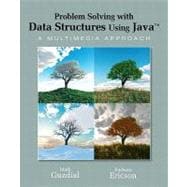
Note: Supplemental materials are not guaranteed with Rental or Used book purchases.
Purchase Benefits
What is included with this book?
Mark Guzdial is a Professor in the School of Interactive Computing at Georgia Tech. An award-winning teacher and active researcher in computing education, he holds a joint Ph.D. In Education and Computer Science from the University of Michigan. Dr. Guzdial directs Project “Georgia Computes!” which is an NSF funded alliance to improve computing education from pre-teen years to undergraduates. He is a member of the ACM Education Board and is a frequent contributor to the ACM SIGCSE (Computer Science Education) Symposium.
Barbara Ericson and Mark Guzdial, are recipients of the 2010 Karl V. Karlstom Outstanding Educator Award for their contributions to broadening participation in computing. They created the Media Computation (MediaComp) approach, which motivates students to write programs that manipulate and create digital media, such as pictures, sounds, and videos. Now in use in nearly 200 schools around the world, this contextualized approach to introductory Computer Science attracts students not motivated by classical algorithmic problems addressed in traditional computer science education. They also lead “Georgia Computes!” an NSF-funded statewide alliance to increase the number and diversity of students in computing education across all of Georgia. Barbara Ericson directs the Institute for Computing Education at Georgia Tech. Mark Guzdial is director of the Contextualized Support for Learning at Georgia Tech. Together they have written three textbooks using the MediaComp approach to engage and inspire student learning in computing. The Karlstrom Award recognizes educators who advanced new teaching methodologies; effected new curriculum development in Computer Science and Engineering; or contributed to ACM’s educational mission.
| Contents | p. iii |
| List of Program Examples | p. vii |
| List of Figures | p. xii |
| Introduction to Java: Object-Oriented Programming for Modeling a World | p. 5 |
| Objects for Modeling a World. | p. 7 |
| Making Representations of a World | p. 8 |
| Why Java? | p. 15 |
| Introduction to Java | p. 19 |
| Whatrsquo;s Java about? | p. 19 |
| Basic (Syntax) Rules of Java | p. 20 |
| Using Java to Model the World | p. 28 |
| Manipulating Pictures in Java | p. 40 |
| Exploring Sound in Java | p. 45 |
| Exploring Music in Java | p. 46 |
| Methods in Java: Manipulating Pictures | p. 51 |
| Reviewing Java Basics | p. 51 |
| Java is about Classes and Methods | p. 56 |
| Methods that return something: Compositing images | p. 63 |
| Creating classes that do something | p. 73 |
| Objects as Agents: Manipulating Turtles | p. 79 |
| Turtles: An Early Computational Object | p. 79 |
| Drawing with Turtles | p. 80 |
| Creating animations with turtles and frames | p. 88 |
| Arrays: A Static Data Structure for Sounds | p. 97 |
| Manipulating Sampled Sounds | p. 97 |
| Inserting and Deleting in an Array | p. 103 |
| Introducing Linked Lists. | p. 109 |
| Structuring Music using Linked Lists | p. 111 |
| JMusic and Imports | p. 111 |
| Starting out with JMusic | p. 115 |
| Making a Simple Song Object | p. 116 |
| Simple structuring of notes with an array | p. 119 |
| Making the Song Something to Explore | p. 119 |
| Making Any Song Something to Explore | p. 128 |
| Exploring Music | p. 151 |
| Structuring Images using Linked Lists | p. 169 |
| Simple arrays of pictures | p. 170 |
| Listing the Pictures, Left-to-Right | p. 170 |
| Listing the Pictures, Layering | p. 176 |
| Reversing a List | p. 185 |
| Animation | p. 186 |
| Lists with Two Kinds of Elements | p. 189 |
| Trees: Hierarchical Structures for Media. | p. 207 |
| Trees of Images | p. 209 |
| Representing scenes with trees | p. 209 |
| Our First Scene Graph: Attack of the Killer Wolvies hellip;. | p. 210 |
| The Classes in the SceneGraph | p. 212 |
| Building a s<$$$> | |
| Table of Contents provided by Publisher. All Rights Reserved. |
The New copy of this book will include any supplemental materials advertised. Please check the title of the book to determine if it should include any access cards, study guides, lab manuals, CDs, etc.
The Used, Rental and eBook copies of this book are not guaranteed to include any supplemental materials. Typically, only the book itself is included. This is true even if the title states it includes any access cards, study guides, lab manuals, CDs, etc.